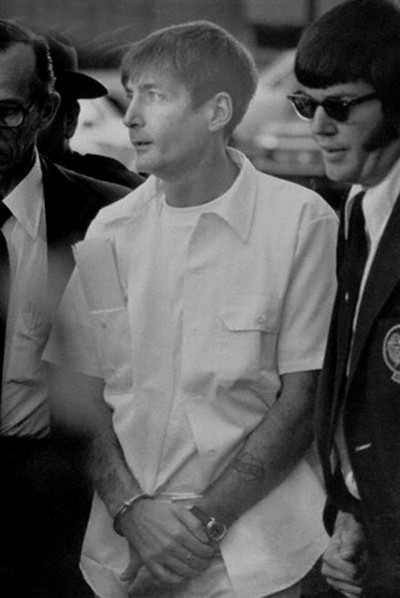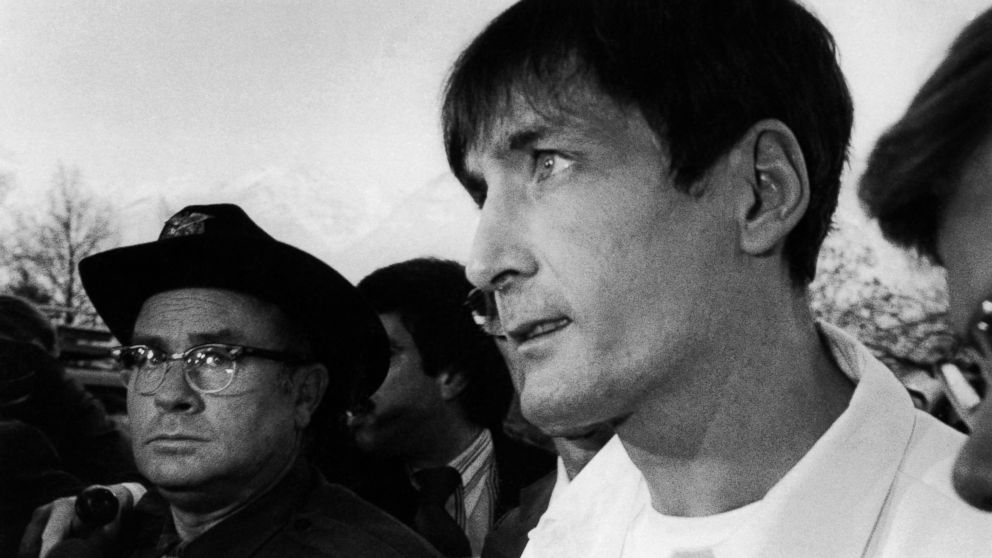Gary Gilmore (Gary Mark Gilmore)

Gilmore was born in McCamey, Texas, on December 4, 1940, the second of four sons to Frank and Bessie Gilmore. Frank Gilmore Sr. (1890–1962), an alcoholic con man, had numerous wives and families, none of whom he supported. He married Bessie (née Brown) (1914 – June 1980), a Mormon outcast from Provo, Utah, in Sacramento, California, on a whim. Gary was born while they were living in Texas under the pseudonym of Coffman to avoid the law. Frank christened his son Faye Robert Coffman, but once they left Texas, Bessie changed it to Gary Mark. This name change proved to be a sore point years later: Gilmore’s mother kept the original “Faye Coffman” birth certificate, and when Gary found it two decades later he assumed he must either be illegitimate or someone else’s son. Gilmore seized on this as the reason why he and his father never got along, and became very upset and walked out on his mother when she tried to explain the name change to him.
The theme of illegitimacy, real or imagined, was common in the Gilmore family. Fay Gilmore, Frank’s mother, once told Bessie that Frank’s father was a famous magician who passed through Sacramento, where she was living. Bessie researched this at the library and came to the conclusion that Frank was the illegitimate son of Harry Houdini. Houdini was only sixteen years old in 1890, the year of Frank Gilmore’s birth, and did not begin his career as a magician until the following year. Mikal Gilmore believes the story to be false, but has stated that both his father and mother believed it.
The family constantly relocated throughout the Western United States during Gary’s childhood, with Frank supporting them by selling fake magazine subscriptions. Gary had a troubled relationship with his father, whom his youngest brother Mikal described as a “cruel and unreasonable man.” Frank Gilmore, Sr. was strict and quick to anger, and would often whip his sons Frank, Jr., Gary and Gaylen with a razor strop, whip or a belt for little or no reason. Less often, he would beat his wife. He mellowed somewhat with age: Mikal reported that Frank whipped him only once, and he never did it again after he told him “I hate you.” In addition, Frank and Bessie would argue loudly and abusively name-call each other. Frank would anger Bessie by calling her crazy, and defame Brigham Young, the second president and prophet of The Church of Jesus Christ of Latter-day Saints, as “Bring ’em Young.” Bessie would retaliate by calling him a “Cat-licker” [Catholic] and threatening to kill him some night. This abuse continued for years, and caused considerable turmoil within the Gilmore family.
In 1952, the Gilmore family settled in Portland, Oregon. As an adolescent, Gary began engaging in petty crime. Although Gilmore had an IQ test score of 133, had high scores on both aptitude and achievement tests, and showed artistic talent, he dropped out of high school in the ninth grade. He ran away from home with a friend to Texas, returning to Portland after several months. At the age of 14, he started a small car theft ring with friends, which resulted in his first arrest. He was released to his father with a warning. Two weeks later he was back in court on another car theft charge. The court remanded him to the MacLaren Reform School for Boys in Oregon, from which he was released the following year. He was sent to Oregon State Correctional Institution on another car theft charge in 1960, and was released later that year. In 1961, Frank, Sr., was diagnosed with terminal lung cancer, and died at the end of June 1962, while Gary was still in prison. Gary heard about his father’s death from one of his jailers. Despite his dysfunctional relationship with his father, he was devastated, and tried to kill himself by slitting his wrists.
In 1962, Gilmore was again arrested and sent to the Oregon State Penitentiary for armed robbery and assault. He faced assault and armed robbery charges again in 1964, and was given a 15-year prison sentence as a habitual offender. A prison psychiatrist diagnosed him with antisocial personality disorder with intermittent psychotic decompensation. He was granted conditional release in 1972 to live weekdays in a halfway house in Eugene, Oregon, and study art at a community college. Gilmore never registered and within a month he was arrested and convicted of armed robbery. Because of his violent behavior in prison, he was transferred from Oregon to the maximum security federal prison in Marion, Illinois, in 1975. He was conditionally paroled in April 1976 and went to Provo, Utah, to live with a distant cousin, Brenda Nicol, who tried to help him find work. Gilmore worked briefly at his uncle Vern Damico’s shoe store and for an insulation company, but he soon returned to his previous lifestyle of stealing, drinking, and getting into fights. Gilmore, then 35, had a relationship with Nicole Baker, a 19-year-old widow and divorcee who had two young children. The relationship was at first casual, but soon became intense and strained due to Gilmore’s aggressive behavior and pressure from Baker’s family to stop her seeing him.
On the evening of July 19, 1976, Gilmore robbed and murdered Max Jensen, a gas station employee in Orem, Utah. The next evening, he robbed and murdered Bennie Bushnell, a motel manager in Provo. Even though they had complied with his demands, he murdered both men. While disposing of the .22 caliber pistol used in both killings, Gilmore accidentally shot himself in his right hand, leaving a trail of blood back to the service garage, where he had left his truck to be repaired prior to murdering Bushnell. Garage mechanic Michael Simpson witnessed Gilmore hiding the gun in the bushes. Seeing the blood on Gilmore’s crudely bandaged right hand when he approached to pay for the repairs to his truck, and hearing on a police scanner of the shooting at the nearby motel, Simpson wrote down Gilmore’s license number and called the police after Gilmore left. Gilmore’s cousin, Brenda, turned him in to police shortly after he phoned her asking for bandages and painkillers for the injury to his hand. The Utah State Police apprehended Gilmore as he tried to drive out of Provo, and he gave up without attempting to flee. He was charged with the murders of Jensen and Bushnell, although the first case was never brought to trial, apparently because there were no eyewitnesses.
Gilmore’s murder trial began at the Provo courthouse on October 5, 1976 and lasted two days. Peter Arroyo, a motel guest, testified that he saw Gilmore in the motel registration office that night. After taking the money, Gilmore allegedly ordered Bushnell to lie down on the floor and then shot him. Gerald F. Wilkes, a FBI ballistics expert, matched the two shell casings and the bullet that killed Bushnell to the gun hidden in the bush, and a patrolman testified that he had traced Gilmore’s trail of blood to that same bush. Gilmore’s two court-appointed lawyers, Michael Esplin and Craig Snyder, made no attempt to cross-examine the majority of the state’s witnesses, and rested without calling any witnesses for the defense. Gilmore protested, and the following day asked the judge if he could take the stand in his own defense, perhaps arguing that due to the dissociation and lack of control he felt at the time, he had a good case for insanity. His attorneys presented the findings of four separate psychiatrists, all of whom had said that Gilmore was aware of what he was doing and that he knew it was wrong at the time. While he did have an antisocial personality disorder, which may have been aggravated by drinking and drugs, he still did not meet the legal criteria for insanity. Gilmore withdrew his request. On October 7, the jury retired to deliberate and by mid-day, they had returned with a guilty verdict. Later that day, the jury unanimously recommended the death penalty due to the special circumstances of the crime.
Gary chose to not pursue habeas corpus relief in federal court. His mother, Bessie, sued for a stay of execution on his behalf. In a five-to-four decision, the US Supreme Court refused to hear his mother’s claim. The Court’s per curiam opinion said that the defendant had waived his rights by not pursuing them. At the time, Utah had two methods of execution — firing squad or hanging. Believing a hanging could be botched, Gilmore chose the former, declaring, “I’d prefer to be shot.” The execution was set for November 15 at 8 AM.
Against his express wishes, Gilmore received several stays of execution through the efforts of the American Civil Liberties Union (ACLU). The last of these occurred just hours before the re-scheduled execution date of January 17. That stay was overturned at 7:30 AM, and the execution was allowed to proceed as planned. At a Board of Pardons hearing in November 1976, Gilmore said of the efforts by the ACLU and others to prevent his execution: “They always want to get in on the act. I don’t think they have ever really done anything effective in their lives. I would like them all — including that group of reverends and rabbis from Salt Lake City — to butt out. This is my life and this is my death. It’s been sanctioned by the courts that I die and I accept that.” During the time Gilmore was on death row awaiting his execution, he attempted suicide twice, the first time on November 16 after the first stay was issued, and again one month later.
Gilmore was executed on January 17, 1977, at 8:07 a.m. by firing squad at Utah State Prison in Draper, Utah. The night before, Gilmore had requested an all-night gathering of friends and family at the prison mess hall. On the evening before his execution, he was served a last meal of steak, potatoes, milk and coffee but consumed only the milk and coffee. His uncle, Vern Damico, who attended the gathering, later claimed to have smuggled in three small, 50ml Jack Daniel’s whiskey bottles which Gilmore supposedly consumed. He was then taken to an abandoned cannery behind the prison, which served as its death house. He was strapped to a chair, with a wall of sandbags placed behind him to trap the bullets. Five gunmen, local police officers, stood concealed behind a curtain with five small holes, through which they aimed their rifles. When asked for any last words, Gilmore simply replied, “Let’s do it.” Rev. Thomas Meersman, the Roman Catholic prison chaplain, administered the last rites to Gilmore. After the prison physician cloaked him in a black hood, Gilmore uttered his last words to Father Meersman: “Dominus vobiscum” (Latin, translation: “The Lord be with you.”) Meersman replied, “Et cum spiritu tuo” (“And with your spirit.”) Gilmore had requested that his organs be donated for transplant purposes. Within hours of the execution, two people received his corneas. His body was then sent for autopsy and was cremated later that day. The following day, his ashes were scattered from an airplane over Spanish Fork, Utah.
Born
- December, 04, 1940
- USA
- McCamey, Texas
Died
- January, 17, 1977
- USA
- Draper, Utah
Cause of Death
- execution by firing squad
Other
- Cremated


